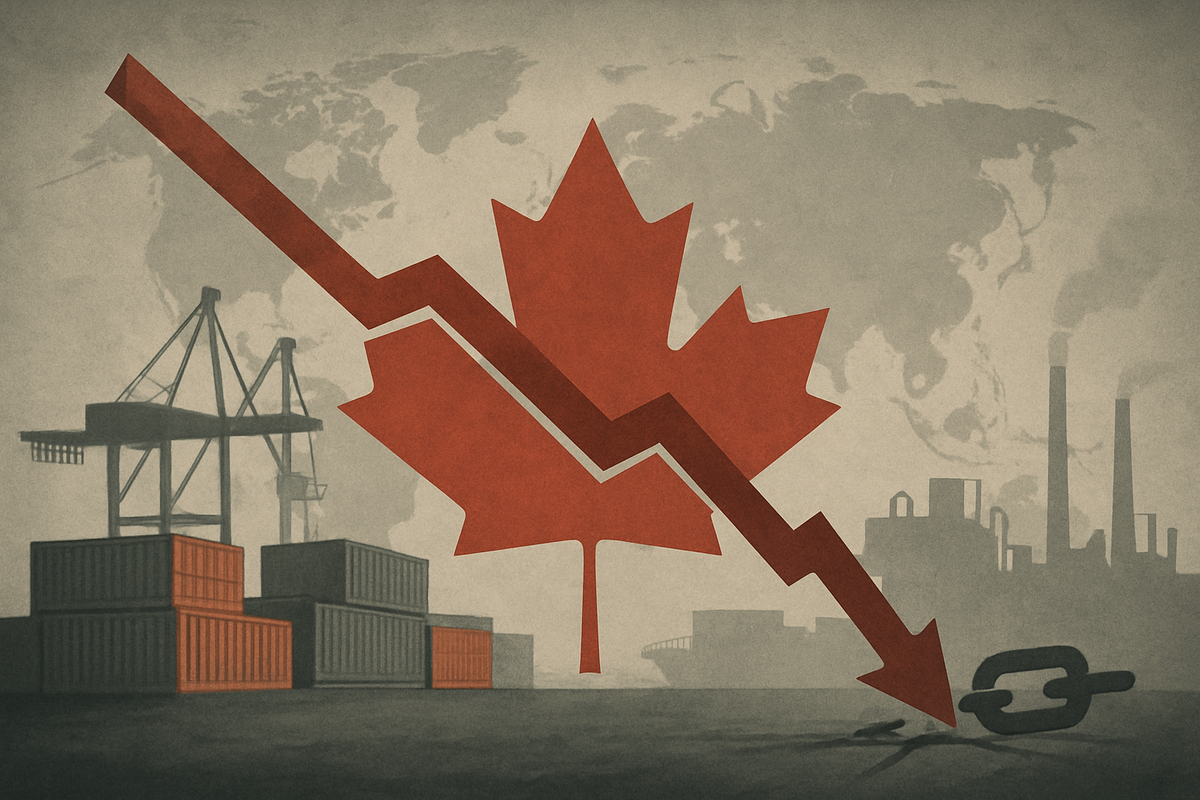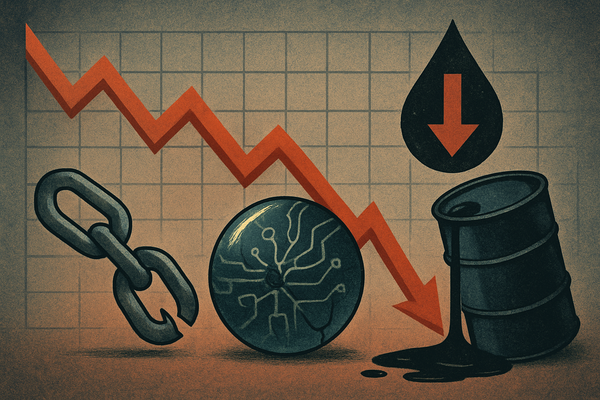Canada's Exports Plummet in Q2 2025 Amidst U.S. Tariffs and Global Slowdown, Sparking Economic Contraction

Canada's economy has been hit by a significant downturn in the second quarter of 2025, as the nation's exports experienced their sharpest decline since the 2009 financial crisis, excluding the pandemic period. According to Statistics Canada, the country's exports plunged by a staggering 7.5% in Q2 2025, a contraction primarily attributed to the ripple effects of new U.S. tariffs on critical Canadian goods and a broader softening of global demand. This dramatic slump has immediately translated into a 1.6% annualized contraction in Canada's real Gross Domestic Product (GDP), signaling a challenging period ahead for the nation's economic landscape.
The unexpected contraction in GDP, which marks the first quarterly decline since Q3 2023, underscores the profound impact of these external pressures. The export woes have not only widened Canada's trade deficit to a record $21.2 billion but have also put a brake on employment growth and deterred business investment. As the Bank of Canada has already responded by cutting its overnight rate in September 2025, the immediate implications suggest a more cautious economic outlook, with potential ramifications for industries, consumers, and investors alike.
Export Crisis Unfolds: Tariffs, Demand, and a Strong Dollar Create a Perfect Storm
The precipitous drop in Canadian exports during Q2 2025 was the result of a confluence of factors, with U.S. trade policies at the forefront. In February 2025, the U.S. initiated a broader trade dispute, culminating in the imposition of significant 25% tariffs on Canadian steel, aluminum, and crucial automotive products, which took effect in March and early April. This protectionist measure directly targeted some of Canada's most vital export sectors, leading to a nearly 25% decline in exports of passenger cars and light trucks alone in Q2. Other key categories, including industrial machinery, intermediate metal products, and building materials, also suffered substantial setbacks. Businesses, anticipating these tariffs, reportedly frontloaded imports in Q1 2025, leading to an exacerbated drop in Q2 as inventories were drawn down.
Beyond the tariffs, a general weakening of global demand further compounded Canada's export challenges. While some advanced economies demonstrated resilience, growth in emerging markets decelerated, contributing to a broader slowdown in international trade. The pervasive uncertainty generated by the U.S. tariffs also played a role, dampening overall demand for Canadian goods and services worldwide. Adding to the competitive pressures, the Canadian dollar experienced a sharp appreciation of 4.9% against the U.S. dollar between April and June 2025, making Canadian exports more expensive and less attractive in international markets. Statistics Canada's data revealed that merchandise exports fell by 9.2%, while service exports, primarily due to a steep decline in travel services, were down 1.4%. Overall, exports of goods and services to the U.S. plummeted by 18.7%.
The immediate market and industry reactions have been palpable. The manufacturing and wholesale sectors, deeply intertwined with export activities, experienced declines or stalled growth. Manufacturing output by mid-year was 3.2% below levels seen in March when the U.S. tariffs were enacted, with over half of manufacturing establishments (54%) and four in ten wholesalers reporting direct impacts from the tariffs in May and June. The labor market has also shown signs of strain, with no net employment growth from February to August 2025, and mass layoffs concentrated in industries such as automotive and steel. Business investment in machinery and equipment saw a significant 9.4% fall in Q2, reflecting heightened trade tensions and economic uncertainty. In response to the deteriorating economic outlook, the Bank of Canada took decisive action in September 2025, reducing its target for the overnight rate, a clear signal of the central bank's concern over the nation's economic trajectory.
Companies on the Brink: Winners and Losers in a Tariff-Laden Market
The sharp decline in Canadian exports, particularly due to U.S. tariffs on key goods, is creating a clear divide between potential winners and losers among public companies and sectors. Industries directly targeted by the tariffs, such as steel, aluminum, and automotive, are facing the most immediate and severe headwinds.
Companies like Stelco Holdings Inc. (TSX: STLC) and ArcelorMittal Dofasco (a subsidiary of NYSE: MT), major players in the Canadian steel industry, are likely to be among the hardest hit. The 25% U.S. tariffs on steel significantly diminish their competitiveness in their largest export market, forcing them to either absorb higher costs, reduce production, or seek alternative, potentially less lucrative, markets. This could lead to reduced revenues, compressed profit margins, and potential workforce reductions. Similarly, aluminum producers such as Alcoa Corporation (NYSE: AA), which operates significant smelting capacity in Canada, will face similar pressures, though their global diversified operations might offer some buffer.
The automotive sector, a cornerstone of Canadian manufacturing, is also under immense pressure. Major auto manufacturers with production facilities in Canada, including Magna International Inc. (TSX: MG; NYSE: MGA), a leading global automotive supplier, and the Canadian operations of Ford Motor Company (NYSE: F), General Motors Company (NYSE: GM), and Stellantis N.V. (NYSE: STLA), are seeing exports of passenger cars and light trucks plummet. The tariffs disrupt established supply chains and increase the cost of vehicles produced in Canada for the U.S. market, potentially leading to production cuts, slower investment in Canadian plants, and a re-evaluation of manufacturing footprints. This directly impacts not only the assemblers but also the vast network of Canadian auto parts suppliers.
Conversely, companies less reliant on direct exports to the U.S. or those serving the domestic market might fare relatively better, or even see indirect benefits from government stimulus aimed at bolstering internal demand. For instance, some Canadian retailers or service providers focused on the domestic market could see a slight uptick if Canadians redirect spending internally, though overall economic contraction would limit this. Furthermore, sectors that are net importers of goods now subject to Canadian countermeasures against U.S. products might see their input costs rise, but this is a more complex dynamic. Companies that can pivot to non-U.S. export markets, although challenging given weakening global demand, might mitigate some losses. However, the pervasive nature of the tariffs and the general economic slowdown mean that few Canadian companies will be entirely immune to the broader economic implications.
Broader Economic Ripples: Trade Wars, Supply Chains, and Policy Shifts
Canada's Q2 2025 export crisis is not an isolated incident but rather a stark manifestation of broader global trade tensions and shifting economic dynamics. This event fits squarely into a growing trend of protectionist policies, where major economies increasingly resort to tariffs and trade barriers as tools of economic leverage. The U.S. imposition of tariffs on Canadian steel, aluminum, and automotive products, following similar actions against other trading partners, highlights a fragmented global trade environment. This environment forces countries like Canada to reassess their reliance on single-market exports and diversify their trade relationships.
The potential ripple effects extend far beyond the directly targeted industries. Supply chains, meticulously built over decades under free trade agreements, are now under immense strain. Automotive supply chains, in particular, are deeply integrated across the U.S.-Canada border, meaning tariffs on finished vehicles or components create significant disruptions for manufacturers on both sides. This could lead to companies reconsidering the efficiency of North American supply chains, potentially seeking to localize production or source from non-tariff-affected regions, which could have long-term structural implications for Canadian manufacturing. Partners in unaffected sectors might also experience indirect impacts through reduced overall economic activity, lower consumer spending, and diminished business confidence.
From a regulatory and policy perspective, this event is likely to trigger significant responses from the Canadian government. Expect increased pressure for retaliatory measures, intensified diplomatic efforts to resolve trade disputes with the U.S., and potentially new programs aimed at supporting affected industries and workers. There could also be a renewed focus on diversifying Canada's trade agreements beyond North America, with increased emphasis on markets in Asia and Europe. Historically, periods of intense trade disputes, such as the Canada-U.S. softwood lumber disputes or the broader trade wars of the 1930s, have demonstrated the long-lasting damage that protectionism can inflict on interconnected economies, often leading to reduced innovation, higher consumer prices, and slower economic growth. The current situation draws parallels, underscoring the potential for a prolonged period of economic adjustment if trade tensions persist.
The Road Ahead: Navigating Uncertainty and Seeking New Horizons
The path forward for Canada's economy in the wake of the Q2 2025 export slump is fraught with both challenges and potential opportunities. In the short term, the immediate focus will be on mitigating the damage from existing U.S. tariffs and addressing the slowdown in global demand. This will likely involve continued diplomatic efforts to de-escalate trade tensions with the U.S., potentially leading to negotiations for tariff removal or adjustments. Domestically, the Canadian government may introduce targeted support programs for industries and workers most affected by the export decline, aiming to prevent widespread layoffs and business failures. The Bank of Canada's recent rate cut signals a commitment to supporting the economy, and further monetary policy adjustments could be on the horizon if the economic contraction deepens.
In the long term, strategic pivots and adaptations will be crucial for Canadian businesses and policymakers. Companies heavily reliant on the U.S. market will need to explore diversification strategies, actively seeking new export markets in Asia, Europe, and other regions. This might involve retooling production lines, adapting products to new market standards, and investing in new trade relationships. For the Canadian government, this crisis could accelerate efforts to strengthen existing free trade agreements and forge new ones, reducing the nation's vulnerability to protectionist policies from any single trading partner. There's also an opportunity to double down on domestic innovation and value-added production, fostering industries that are less susceptible to external trade shocks.
Potential scenarios range from a gradual recovery, assuming a resolution to U.S. tariffs and a rebound in global demand, to a more prolonged period of economic stagnation if trade tensions persist and global economic growth remains subdued. Market opportunities may emerge in sectors that can cater to increased domestic demand or those that can successfully pivot to underserved international markets. Challenges will include maintaining competitiveness, attracting foreign investment in a volatile trade environment, and managing potential inflationary pressures from disrupted supply chains. Investors should watch for signs of de-escalation in U.S.-Canada trade relations, indicators of a rebound in global manufacturing and trade, and the effectiveness of Canadian government and central bank interventions in stabilizing the economy.
A Challenging Outlook: Key Takeaways and Investor Watch Points
Canada's Q2 2025 export performance serves as a stark reminder of the nation's economic vulnerability to global trade dynamics and protectionist policies. The sharp 7.5% decline in exports, primarily driven by U.S. tariffs on steel, aluminum, and automotive products, coupled with weakening global demand and a strong Canadian dollar, has pushed the economy into a 1.6% annualized contraction in GDP. This event underscores the immediate and far-reaching consequences of trade disputes, impacting manufacturing, employment, business investment, and ultimately, consumer prices.
Moving forward, the market faces significant uncertainty. The immediate challenge is navigating the ongoing trade tensions with the U.S. and adapting to a more subdued global economic environment. The Canadian economy's resilience will be tested, with a greater emphasis on domestic demand to cushion external shocks, as evidenced by the Q2 increase in household consumption and residential investment. However, this domestic strength alone may not be sufficient to offset a sustained decline in export-driven sectors.
For investors, key takeaways include the increased risk profile for Canadian companies heavily exposed to U.S. export markets, particularly in the steel, aluminum, and automotive sectors. Diversification of portfolios and a focus on companies with robust domestic operations or diversified international revenue streams may become more attractive. Investors should closely monitor developments in U.S.-Canada trade negotiations, looking for any signals of tariff relief or resolution. Additionally, tracking global economic indicators, commodity prices, and the Bank of Canada's monetary policy decisions will be crucial in assessing the nation's economic trajectory in the coming months. The lasting impact of this export crisis will depend on both policy responses and the broader evolution of global trade relations, shaping Canada's economic landscape for the foreseeable future.
This content is intended for informational purposes only and is not financial advice



